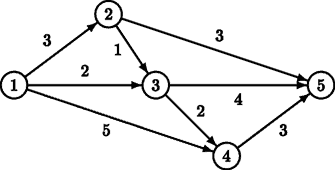Poj 最短路和次短路的个数 Dij+优化?。
Description
Tour operator Your Personal Holiday organises guided bus trips across the Benelux. Every day the bus moves from one city S to another city F. On this way, the tourists in the bus can see the sights alongside the route travelled. Moreover, the bus makes a number of stops (zero or more) at some beautiful cities, where the tourists get out to see the local sights.
Different groups of tourists may have different preferences for the sights they want to see, and thus for the route to be taken from S to F. Therefore, Your Personal Holiday wants to offer its clients a choice from many different routes. As hotels have been booked in advance, the starting city S and the final city F, though, are fixed. Two routes from S to F are considered different if there is at least one road from a city A to a city B which is part of one route, but not of the other route.
There is a restriction on the routes that the tourists may choose from. To leave enough time for the sightseeing at the stops (and to avoid using too much fuel), the bus has to take a short route from S to F. It has to be either a route with minimal distance, or a route which is one distance unit longer than the minimal distance. Indeed, by allowing routes that are one distance unit longer, the tourists may have more choice than by restricting them to exactly the minimal routes. This enhances the impression of a personal holiday.

For example, for the above road map, there are two minimal routes from S = 1 to F = 5: 1 → 2 → 5 and 1 → 3 → 5, both of length 6. There is one route that is one distance unit longer: 1 → 3 → 4 → 5, of length 7.
Now, given a (partial) road map of the Benelux and two cities S and F, tour operator Your Personal Holiday likes to know how many different routes it can offer to its clients, under the above restriction on the route length.
Input
The first line of the input file contains a single number: the number of test cases to follow. Each test case has the following format:
One line with two integers N and M, separated by a single space, with 2 ≤ N ≤ 1,000 and 1 ≤ M ≤ 10, 000: the number of cities and the number of roads in the road map.
M lines, each with three integers A, B and L, separated by single spaces, with 1 ≤ A, B ≤ N, A ≠ B and 1 ≤ L ≤ 1,000, describing a road from city A to city B with length L.
The roads are unidirectional. Hence, if there is a road from A to B, then there is not necessarily also a road from B to A. There may be different roads from a city A to a city B.
One line with two integers S and F, separated by a single space, with 1 ≤ S, F ≤ N and S ≠ F: the starting city and the final city of the route.
There will be at least one route from S to F.
Output
For every test case in the input file, the output should contain a single number, on a single line: the number of routes of minimal length or one distance unit longer. Test cases are such, that this number is at most 109 = 1,000,000,000.
Sample Input
2
5 8
1 2 3
1 3 2
1 4 5
2 3 1
2 5 3
3 4 2
3 5 4
4 5 3
1 5
5 6
2 3 1
3 2 1
3 1 10
4 5 2
5 2 7
5 2 7
4 1
Sample Output
3
2 http://www.cnblogs.com/candy99/p/5873047.html //参考代码 注意仔细体会vis数组,必不可少的,不仅仅是优化时间
#include<cstdio>
#include<cstring>
#include<algorithm>
#include<queue>
using namespace std;
const int N=;
const int M=;
const int INF=0x3f3f3f3f;
int n,m;
struct edge{
int to,w,next;
}e[M];
int head[N],tot=;
void add(int u,int v,int w){
e[tot].to=v;
e[tot].w=w;
e[tot].next=head[u];
head[u]=tot++;
}
int d[N][],vis[N][],cnt[N][];
struct hn{
int u,d,p;
hn(int a=,int b=,int c=):u(a),d(b),p(c){}
bool operator < (const hn &rhs)const{
return d>rhs.d;
}
};
void Dij(int s){
priority_queue<hn>Q;
memset(vis,,sizeof(vis));
memset(cnt,,sizeof(cnt));
for(int i=;i<=n;++i) d[i][]=d[i][]=INF;
Q.push(hn(s,,));
d[s][]=,cnt[s][]=;
while(!Q.empty()){
hn now=Q.top();Q.pop();
int u=now.u,p=now.p;
if(vis[u][p]) continue;
vis[u][p]=;
for(int i=head[u];i+;i=e[i].next){
int v=e[i].to,w=e[i].w;
if(d[v][]>d[u][p]+w) {
d[v][]=d[v][],cnt[v][]=cnt[v][];
d[v][]=d[u][p]+w,cnt[v][]=cnt[u][p];
Q.push(hn(v,d[v][],));
Q.push(hn(v,d[v][],));
}
else if(d[v][]==d[u][p]+w) cnt[v][]+=cnt[u][p];
else if(d[v][]>d[u][p]+w) {
d[v][]=d[u][p]+w;
cnt[v][]=cnt[u][p];
Q.push(hn(v,d[v][],));
}
else if(d[v][]==d[u][p]+w) cnt[v][]+=cnt[u][p];
}
}
}
int main(){
int T,u,v,w;
for(scanf("%d",&T);T--;){
memset(head,-,sizeof(head));
tot=;
scanf("%d%d",&n,&m);
for(int i=;i<=m;++i) { scanf("%d%d%d",&u,&v,&w);add(u,v,w);}
int s,f;
scanf("%d%d",&s,&f);
Dij(s);
if(d[f][]==d[f][]+) cnt[f][]+=cnt[f][];
printf("%d\n",cnt[f][]);
}
}
Poj 最短路和次短路的个数 Dij+优化?。的更多相关文章
- poj 3463 Sightseeing( 最短路与次短路)
http://poj.org/problem?id=3463 Sightseeing Time Limit: 2000MS Memory Limit: 65536K Total Submissio ...
- POJ 3635 - Full Tank? - [最短路变形][手写二叉堆优化Dijkstra][配对堆优化Dijkstra]
题目链接:http://poj.org/problem?id=3635 题意题解等均参考:POJ 3635 - Full Tank? - [最短路变形][优先队列优化Dijkstra]. 一些口胡: ...
- POJ - 3463 Sightseeing 最短路计数+次短路计数
F - Sightseeing 传送门: POJ - 3463 分析 一句话题意:给你一个有向图,可能有重边,让你求从s到t最短路的条数,如果次短路的长度比最短路的长度多1,那么在加上次短路的条数. ...
- POJ 3463 有向图求次短路的长度及其方法数
题目大意: 希望求出走出最短路的方法总数,如果次短路只比最短路小1,那也是可取的 输出总的方法数 这里n个点,每个点有最短和次短两种长度 这里采取的是dijkstra的思想,相当于我们可以不断找到更新 ...
- POJ 3463 Sightseeing 【最短路与次短路】
题目 Tour operator Your Personal Holiday organises guided bus trips across the Benelux. Every day the ...
- dijkstra(最短路)和Prim(最小生成树)下的堆优化
dijkstra(最短路)和Prim(最小生成树)下的堆优化 最小堆: down(i)[向下调整]:从第k层的点i开始向下操作,第k层的点与第k+1层的点(如果有)进行值大小的判断,如果父节点的值大于 ...
- POJ---3463 Sightseeing 记录最短路和次短路的条数
Sightseeing Time Limit: 2000MS Memory Limit: 65536K Total Submissions: 9247 Accepted: 3242 Descr ...
- 最短路和次短路问题,dijkstra算法
/* *题目大意: *在一个有向图中,求从s到t两个点之间的最短路和比最短路长1的次短路的条数之和; * *算法思想: *用A*求第K短路,目测会超时,直接在dijkstra算法上求次短路; ...
- UESTC30-最短路-Floyd最短路、spfa+链式前向星建图
最短路 Time Limit: 3000/1000MS (Java/Others) Memory Limit: 65535/65535KB (Java/Others) 在每年的校赛里,所有进入决赛的同 ...
随机推荐
- 使用VSCode连接到IBM Cloud区块链网络
文章目录 从IBM Cloud控制面板导出连接信息 在VSCode中创建gateway和wallet 在VSCode中提交transaction 上篇文章我们讲到怎么在IBM Cloud搭建区块链环境 ...
- Navicat premium15安装破解教程
Navicat premium15安装破解教程 注意:安装之前请卸载干净navicat,不要覆盖安装 1.去官网下载Navicat premium15的安装包 官网地址:https://www.nav ...
- css-position之fixed vs sticky
css-position之fixed vs sticky fixed(固定定位) 元素相对于浏览器窗口是固定的,即使是窗口滚动,元素也是固定的 sticky(粘性定位) 基于用户滚定动来进行定位的, ...
- 暑期档追剧指南曝光 HUAWEI nova 2系列再放实用三大招
火辣辣的夏季来啦,每年这时火热的不只天气,还有暑期黄金档影视剧的激烈争夺战.今年有<择天记>收视率珠玉在前,<欢乐颂2>更是引发全民追剧热潮,"小花"赵丽颖 ...
- Java大数据秋招面试题
以下为整理的自己秋招遇到的面试题:主要是Java和大数据相关题型:根据印象整理了下,有些记不起来了. 死锁.乐观锁.悲观锁synchronized底层原理及膨胀机制ReetrantLock底层原理,源 ...
- Java——抽象类与接口的前世今生
该系列博文会告诉你如何从入门到进阶,一步步地学习Java基础知识,并上手进行实战,接着了解每个Java知识点背后的实现原理,更完整地了解整个Java技术体系,形成自己的知识框架. 1.抽象类: 当编写 ...
- 大富翁 线段树+二分 +dfs
https://csustacm.fun/problem/2033 这个题目还是比较简单的,但是比赛的时候没有像清楚,用了一个不太熟悉的数据结构主席树, 所以出现了bug,主席树的bug是真的难找. ...
- zigbee通用IO口小作业
独立新建工程并编写.编译代码,实现按键控制流水灯运行,完成以下任务要求: [1]程序开始运行时,D4.D3.D6.D5灯全亮一会,然后全灭一会,开始进入流水灯. [2]流水灯的运行过程为:D4灯亮,其 ...
- java基础篇 之 再探内部类跟final
之前写过一篇文章:从垃圾回收机制解析为什么局部内部类只能访问final修饰的局部变量以及为什么加final能解决问题,经过这两天的学习,发现有些不对,必须再来捋一捋 先看之前的例子: /** * @a ...
- JS实现显示来访者的停留时间
显示来访者的停留时间 <script language="javascript"> var ap_name = navigator.appName; var ap_vi ...
